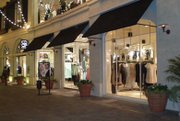Department Stores Are Back in Business
This could be the year of the department store.
Federated Department Stores is still riding the wave of its gargantuan 2006 growth, following its acquisition of the May Co. and the subsequent conversion of 400 Robinsons-May stores to the Macy’s nameplate. Meanwhile, retailers such as Nordstrom, JCPenney, Kohl’s and Dillard’s are expanding or renovating the square footage oftheir department stores in an effort to stay competitive with the massive Federated.
Indeed, the entire sector of departmentstore retailers may be in store for a big leap forward in 2007, according to Michael Exstein, a retail analyst with Credit Suisse.
The growth spurt should increase the collective square footage of American department stores by 3.3 percent, Exstein wrote in a research paper published on March 23.
More real estate equals more sales—or so the conventional wisdom goes. Exstein expects department-store sales to grow around 3.7 percent in 2007. This growth will be fueled by the ongoing department-store land rush.
More than five years ago, many industry watchers dismissed department stores as the dinosaurs of the retail industry. They were derided as offering outmoded formats and bland fashions that looked the same throughout the sector.
But in the past couple of years, the words “new” and “stylish” have been more apt to be used as describing department stores. According to the International Council of Shopping Centers, the public has been increasingly choosing department stores as a shopping destination.
The New York–- based trade group for shopping centers found that department stores have experienced healthy growth over the past three years. The department- store sector increased 4.5 percent in 2006 compared with the previous year’s samestore sales average of a 2.2 percent increase. In 2004, the growth was a measly 1.6 percent.
Department stores’ popularity increased when stores learned how to adapt to the public’s changing tastes, according to retail analysts.
Like a specialty store
Having fashion-forward merchandise has always been crucial for department stores, but directional fashions have become a specific focus for department-store buyers in the past few years, said Janine Blain, the West Coast director for retail consultancy The Doneger Group. “Department stores want to be more like specialty stores,” Blain said.
Indeed, department stores have been invading specialty boutiques’ long-held territory by offering greater selection, sometimes championing up-and-coming designers, and targeting specific slivers of the fashion-buying public.
In the past few years, Nordstrom’s Brass Rail section has been celebrated for championing the burgeoning premium-denim styles for the young men’s demographic.
Bloomingdale’s has found increasing success by catering to the fashion-forward 35- to 45-year-old woman with its shop-in-a-shop called Quotation. There are more than 16 Quotation shops in Bloomingdale’s. By 2009, the concept might be rolled out to the entire chain.
“There are so many different niches of apparel now. No store can offer all of it,” said Lynne Sperling, owner of San Marino, Calif.–based retail consultants Sperling & Hileman Group LLC. Department stores have “taken segments of that marketplace and chosen to focus on the customers’ needs in that segment,” she added.
Finding a place
In the past, when large regional malls dominated the retail landscape, the department stores typically were big enough to deserve the moniker of “anchor” at giant shopping centers.
But in the past few years, smaller lifestyle centers and open-air retail centers have been in vogue. There’s no room for giant department stores in the new lifestyle centers, so department stores had to edit themselves and build different-sized stores that would best serve customers, according to Todd M. Russell, senior vice president of retail leasing and marketing at Caruso Affiliated, a developer of open-air lifestyle centers, including The Grove in Los Angeles.
“They can be chameleon-like in the sense of size and format,” Russell said. While the department stores typically are consistent in terms of label or service, they’ve been experimenting with smaller size to fit a property or tastes of consumers in a certain area.
On March 22, a 10,000-square-foot Barneys Co-Op, the store’s highly edited contemporary store, opened at The Grove. The new store is smaller than Barneys’ 45,000-square-foot flagship store in Boston, which opened in 2006, and much smaller than some of the chain’s Barneys New York stores, which can span more than 200,000 square feet.
And while small department stores are the latest trend, it doesn’t mean the end of big marquee stores. In 2006, Bloomingdale’s opened a 330,000-square-foot flagship store at the Westfield San Francisco Centre. On May 4, it will open a 292,000-square-foot store at South Coast Plaza.
Will it last?
Consumers have not had a long time to associate the words “stylish” and “fresh” with department stores, but the words may stick.
Since 2004, Pam Danziger has surveyed more than 1,000 luxury shoppers at the end of every quarter. The results are published in the Luxury Consumer Tracking Service surveys, published by her Stevens, Penn.–based company, Unity Marketing.
Her shoppers, which represent the top 25 percent of the wealthiest households in America, have consistently named luxury department stores as their favorite destinations for fashion. The answer did not come as a surprise to Danziger, but the growing influence of the Internet did. Online shopping has been rapidly growing in popularity, and e-commerce stores typically rank second or third as preferred destinations for luxury shopping. Danziger said that her survey does not break down by store identity, but she has found a reason for Internet popularity: time.
“Time is more valuable than money for the super-luxury consumer,” she said, noting that the department-store sector has listened to its consumer, and departmentstore e-commerce sites from Neiman Marcus (www.neimanmarcus.com) to Bloomingdale’s (www.bloomingdales.com) have reported good growth.






















